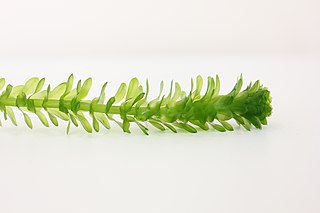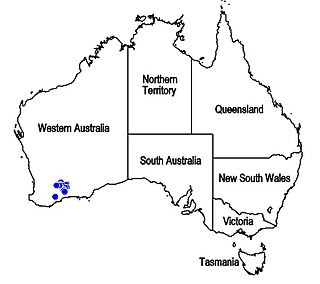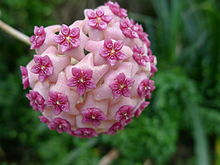
The Territory of Christmas Island is an Australian external territory comprising the island of the same name. It is located in the Indian Ocean around 350 kilometres south of Java and Sumatra and about 1,550 km (840 nmi) northwest of the closest point on the Australian mainland. It has an area of 135 square kilometres (52 sq mi).

Hoya is a genus of over 500 accepted species of tropical plants in the dogbane family, Apocynaceae. Most are native to several countries of Asia such as the Philippines, India, Thailand, Malaysia, Vietnam, Bangladesh, Indonesia, Polynesia, New Guinea, and many species are also found in Australia.

The Christmas imperial pigeon or Christmas Island imperial pigeon, also known as Black imperial pigeon, Dusky imperial pigeon, Wharton's imperial pigeon, or burong pergam, is a large imperial pigeon endemic to Christmas Island in the northeastern Indian Ocean. It has an overall grey-blue colouration, and juveniles are duller than adults. It makes a soft purring coo sound and a deeper whoo sound comparable to a cow mooing. It lays one glossy white egg per brood, and is possibly somewhat colonial.

Hibbertia scandens, sometimes known by the common names snake vine, climbing guinea flower and golden guinea vine, is a species of flowering plant in the family Dilleniaceae and is endemic to eastern Australia. It is climber or scrambler with lance-shaped or egg-shaped leaves with the narrower end towards the base, and yellow flowers with more than thirty stamens arranged around between three and seven glabrous carpels.

HMS Egeria was a 4-gun screw sloop of the Fantome class launched at Pembroke on 1 November 1873. She was named after Egeria, a water nymph of Roman mythology, and was the second ship of the Royal Navy to bear the name. After a busy career in the East Indies, Pacific, Australia and Canada, she was sold for breaking in 1914 and was burnt at Burrard Inlet in British Columbia.

Egeria densa, the large-flowered waterweed or Brazilian waterweed, is a species of Egeria native to warm temperate South America in southeastern Brazil, Argentina, Chile and Uruguay. It is considered a problematic invasive species due to its use in home aquariums and subsequent release into non-native ecosystems.
Joseph Jackson Lister FRS was a British zoologist and plant collector from Leytonstone who collected biological specimens during travels in Africa, Asia, Australasia and the Pacific region.
Zehneria alba is a species of flowering plant in the cucumber and gourd family, Cucurbitaceae. It is endemic to Christmas Island, an Australian territory in the northeastern Indian Ocean. The specific epithet is from the Latin albus (white), referring to the colour of the flowers.
Abutilon listeri , commonly known as the lantern flower, is a tropical shrub in the Malvaceae or mallow family. It is endemic to Christmas Island, an Australian territory in the north-eastern Indian Ocean. Its specific epithet honours British zoologist and plant collector Joseph Jackson Lister, who visited the island on HMS Egeria in 1887.
Asplenium listeri, commonly known as the Christmas Island spleenwort, is a species of fern in the family Aspleniaceae. It is endemic to Christmas Island, an Australian territory in the northeastern Indian Ocean. Its specific epithet honours British zoologist and plant collector Joseph Jackson Lister, who visited the island on HMS Egeria in 1887 and was the first to collect a specimen.
Dicliptera maclearii is a species of plant in the family Acanthaceae which is endemic to Christmas Island, an Australian territory in the north-eastern Indian Ocean. Its specific epithet honours John Maclear, captain of the survey vessel HMS Flying Fish, which visited Christmas Island in 1886.
Peperomia rossii is a species of plant in the family Piperaceae. It is endemic to Christmas Island, an Australian territory in the northeastern Indian Ocean. Its specific epithet honours the Clunies-Ross family which established the Flying Fish Cove settlement on Christmas Island in 1888.
Dendrobium nativitatis, commonly known as the Christmas Island crimp orchid, is a species of epiphytic orchid that is endemic to Christmas Island, an Australian territory in the north-eastern Indian Ocean. It has long, straggly stems, flattened pseudobulbs, a single leathery leaf and a single pale yellow flower.
Phreatia listeri, commonly known as the Christmas Island caterpillar orchid, is a plant in the orchid family and is an epiphyte with four to six flat, blunt leaves in a fan-like arrangement. A large number of tiny, greenish white flowers are arranged along a thin flowering stem. It is endemic to Christmas Island.

Ehretia microphylla, synonym Carmona retusa, also known as the Fukien tea tree or Philippine tea tree, is a species of flowering plant in the borage family, Boraginaceae.

Cassytha filiformis or love-vine is an orangish, wiry, parasitic vine in the family Lauraceae. It is found in coastal forests of warm tropical regions worldwide including the Americas, Indomalaya, Australasia, Polynesia and tropical Africa.

Prostanthera porcata is a species of flowering plant in the family Lamiaceae and is endemic to the Budawang Range in south-eastern New South Wales. It is a small, erect shrub with glabrous branches, elliptic leaves and deep pink or pink and cream-coloured flowers.

Hemiphora lanata is a flowering plant in the mint family Lamiaceae and is endemic to the south-west of Western Australia. It is a sprawling shrub with its branches and leaves densely covered with white, woolly hairs and with deep pink or dark red, curved, tube-shaped flowers with spreading petal lobes on the end. It is similar to Hemiphora exserta except for its cottony leaf-covering and its longer stamens.

Passiflora pectinata is a species of flowering plant native to the West Indies.

Heptapleurum ellipticum, commonly known in Australia as the climbing umbrella tree, is a plant in the family Araliaceae native to the Indian subcontinent, Indochina, Malesia, Papuasia and Australia.












